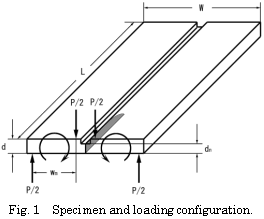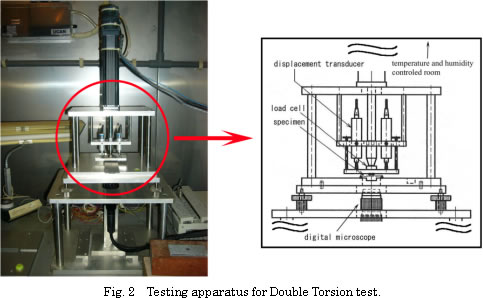
Subcritical Crack Growth in Rock
| Tel: +81-11-706-6325 |
 Researcher:
Researcher:
 Yoshitaka NARA
Yoshitaka NARA
Division of Field Engineering for Environment

Background
Long-term stability is required for structures in rock mass, such as power plants in underground, caverns for storing liquefied petroleum or natural gas (LPG or LNG), or repositories for radioactive wastes in underground. To ensure the long-term stability of structures in rock mass, it is necessary to know the time-dependent behavior of rock. Therefore, it is very important to study the problems of time-dependent rock deformation and fracturing. In classical fracture mechanics, it has been considered that crack growth occurs when the stress intensity factor at the crack tip reaches a critical level, that is, the fracture toughness. However, crack growth can occur even when the stress intensity factor is less than the critical level. This is called as “subcritical crack growth”. Under low homologous temperatures and atmospheric pressure, the main mechanism of subcritical crack growth is stress corrosion, which is a weakening process by stress-aided chemical reaction at the crack tip under tension. For silicate materials, stress corrosion is a weakening process of siloxane bond ( ) and the corrosive agent is likely to be water. Based on the above background, the study of subcritical crack growth is conducted. Especially, the effects of the surrounding environment and rock fabric on subcritical crack growth in rock are investigated.
Description of Experiment
 Double Torsion (DT) method is used as an experimental method. A schematic illustration of the specimen and the loading configuration is shown in Fig. 1. The stress intensity factor is independent of the crack length in DT method. Hence, this method is convenient when using opaque materials for which crack length measurements are difficult, such as rock.The experimental apparatus is shown in Fig. 2. The DT specimen was loaded by an electrically powered cylinder using ball bearings. The crack growth was monitored using a digital microscope placed under the specimen. The apparatus was placed in a temperature and humidity controlled room.
Double Torsion (DT) method is used as an experimental method. A schematic illustration of the specimen and the loading configuration is shown in Fig. 1. The stress intensity factor is independent of the crack length in DT method. Hence, this method is convenient when using opaque materials for which crack length measurements are difficult, such as rock.The experimental apparatus is shown in Fig. 2. The DT specimen was loaded by an electrically powered cylinder using ball bearings. The crack growth was monitored using a digital microscope placed under the specimen. The apparatus was placed in a temperature and humidity controlled room.
 It has been clarified that pre-existing microcracks and water vapor affected the crack growth in rock in air.The water vapor pressure and the density of microcracks parallel to the crack propagation direction facilitated the crack growth.
It has been clarified that pre-existing microcracks and water vapor affected the crack growth in rock in air.The water vapor pressure and the density of microcracks parallel to the crack propagation direction facilitated the crack growth.
